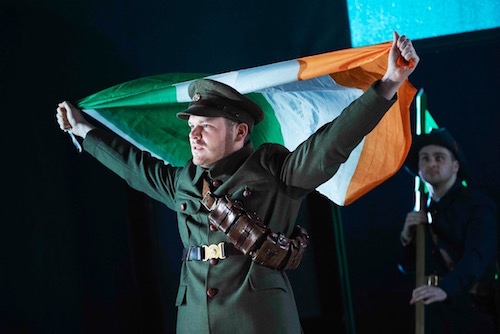
Sean Casey’s Famous Irish Drama Returns to Toronto Stages After 26 Years
A century ago, the 1916 Easter Rising threatened to tear Ireland apart. Six violent days became the culmination of years of rage and mistrust of the seemingly indifferent British government – and the growing desire for a free and independent Ireland that perhaps began to ignite with the Great Famine. After a 26-year absence from Canada, the national theatre of Ireland, Abbey Theatre, brings The Plough and The Stars, Sean O’Casey’s famous historical drama about the Rising, to Canadian Stage for five performances.
Though the theatre was also the 1926 play’s first home, there’s nothing that feels historical or preserved about this production. The aggressively contemporary staging is a near-complete success, crackling with electricity and a current, vital relevance.
In The Plough and the Stars, the story centres around the everyday residents of a Dublin tenement – both before the revolution, and as the armed uprising begins. Some, like elder Peter Flynn (James Hayes), feel the stirrings of Irish pride as a meeting whips the city into a frenzy.
Young Covey, (portrayed with cheeky verve by Ciaran O’Brian) is mostly concerned with Socialist philosophy, Jack Clitheroe (Ian-Lloyd Anderson) with his own potential career advancement in the military, and Nora Clitheroe, Jack’s insecure wife (Kate Stanley Brennan), just wants to keep her loved ones home and safe. Meanwhile, nosy neighbour Mrs. Gogan (Janet Moran) hangs around spouting comic portents of doom, and Bessie Burgess (Hilda Fay) publicly and fiercely broadcasts her sorrow at having a son at WWI’s front lines.
The electric feeling starts from the very beginning, when a pale-faced young girl, the consumptive Mollser (Rachel Gleeson), steps out to tremulously sing the Irish national anthem. The opening night audience (packed with Irish representatives) sang along, but stopped short as a starkly disturbing image arose from the comedy. This is characteristic of the play and its gleefully anachronistic staging (by director Sean Holmes), which increasingly shows us the violence encroaching at the edges of this “normal” world.
These are powerful stories of “ordinary people” caught up in a conflict that only some of them feel passionately about and fewer of them understand; the play reminds us that people in war are just people, even when larger-than-life things are happening around them.
This focus on domestic life plays up the comedy, but contains its own dark undercurrents and small tragedies. The relationship between the Clitheroes changes from a charming flirtation to cold brutality in what seems like an instant, foreshadowing the dangers to come. The foregrounded squabbles between the characters, which dominate the first act and much of the second, are insult-strewn and hilarious even when vicious, but are eventually eclipsed by real horror.
It’s emotional whiplash (in a good way), and it feels a little dangerous. One can see why the audience for the original 1926 production rioted, and why the updated staging works; preserving the provocative nature of the piece takes precedence over a strict adherence to era. Costumes, props, and music are all of the here and now.
Pub patrons hurl plastic cups to the floor and walk over them, making satisfying crunches. Looters steal XBoxes. Microphones are used when the characters directly “perform” for the audience. The bartender switches on a television broadcast of the demagogic Pro-Ireland speech, while in the background, its flickering lights bathe the faces of the ones who wait for their families to return. It could feel gimmicky; instead, it feels exciting and fresh.
The set is industrial and multipurpose: gleaming, bare, and versatile. It features unexpected, built-in surprises as everything threatens to take a tumble, mirroring the lives of those within.
The performances are top-notch, from Brennan’s dramatic fall from grace into madness, to Fay’s seething, coiled anguish. David Ganly in particular gets laughs as the Falstaffian character Fluther Good, who likes his drink and his women, but craves admiration more. His choreography with a rampaging, spraying beer can is pure stage magic, and his obsessive misuse of one particular vocabulary word is priceless.
The shambolic quality of the dialogue and plot, particularly in the first act, may not appeal to everyone, and the ending to all this vitality is slightly disappointing. In the last few minutes, things take a turn for the maudlin, and the staging choices seem cliche. However, O’Casey’s satirical beacon shines through, with the amplifying assistance of modern technology. The Plough and the Stars is only here for five performances and I wouldn’t miss it; let’s hope we don’t have to wait another 26 years for Abbey Theatre’s return.
Details:
- The Plough and the Stars plays at the Bluma Appel Theatre (27 Front Street East) until September 18.
- Thursday and Saturday shows are at 8:00PM, Friday at 7:00PM and Sunday matinee is at 1:00PM
- Tickets are $29-99 and can be purchased online or by calling the Box Office at (416) 368-3110.
Photo of Lloyd Cooney and Liam Heslin by Ros Kavanagh
